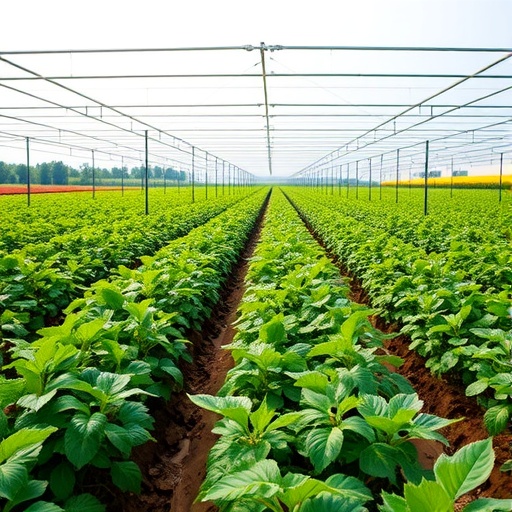In a groundbreaking advancement for agricultural technology, researchers at Zhejiang University have unveiled an innovative framework known as ChatLeafDisease (ChatLD), which harnesses the power of large language models (LLMs) to classify plant diseases using only textual descriptions of symptoms. Unlike traditional deep learning models that rely heavily on vast amounts of labeled image data, ChatLD operates through a training-free, text-driven architecture, demonstrating an unprecedented 88.9% accuracy in diagnosing six common diseases affecting tomato crops. This breakthrough not only dramatically reduces dependence on costly, labor-intensive image datasets but also sets the stage for scalable, cross-crop disease detection crucial for the future of sustainable farming.
Crop diseases and pests are notorious for ravaging yields, particularly in developing regions where agricultural productivity is vital for food security. Estimates attribute up to 50% of crop losses in these areas to such biotic stressors, underscoring the urgency for efficient diagnostic tools. While deep learning and computer vision have made strides in automating disease recognition, their utility remains constrained by the requirement for extensive, domain-specific annotated image libraries. Moreover, adapting these models to new crops or changing environmental conditions typically necessitates time-consuming retraining, rendering them less practical for real-world deployment, especially in resource-limited settings.
Large language models like GPT-4 and Gemini have recently showcased impressive zero-shot reasoning and generalization capabilities across fields including medicine and finance. However, their application in the agricultural domain, particularly for plant disease diagnostics, has remained largely unexplored. Motivated by this gap, the Zhejiang University team pioneered a novel approach to leverage LLMs’ natural language processing strengths without the need for retraining, using sophisticated prompt engineering techniques like Chain-of-Thought (CoT) prompting to facilitate logical symptom assessment and disease classification.
Core to the ChatLD framework is the synthesis of a detailed textual database cataloguing disease symptoms alongside a CoT-guided reasoning mechanism. This agent algorithmically evaluates how well the visual patterns—interpreted through descriptive inputs—align with characteristic disease features. By simulating step-by-step diagnostic reasoning, ChatLD circumvents the dependency on image data for training, enabling it to function flexibly across different crops based solely on symptom descriptions.
Comparative experiments underscore ChatLD’s superior performance relative to state-of-the-art baselines. When tested on tomato datasets, it outperformed GPT-4o, Gemini-1.5-pro, and even the vision-language model CLIP, achieving an accuracy of 88.9% compared to 45.9%, 56.1%, and 64.3% respectively. The integration of Chain-of-Thought prompting substantially enhanced the model’s reasoning capacity, mitigating confusion between visually similar pathogens such as Early Blight and Late Blight. For key diseases like Late Blight, Mosaic Virus, and Yellow Leaf Curl Virus, ChatLD correctly identified over 88% of samples, highlighting its diagnostic precision.
Critically, ablation studies revealed that the logical scoring rules embedded within the system are indispensable; their removal led to a dramatic accuracy drop from 90.3% to 51.8%, confirming their role in structured reasoning. Additionally, the clarity and conciseness of disease descriptions exerted a profound impact on performance, improving accuracy by more than 40%, which emphasizes the importance of high-quality textual knowledge bases in LLM-driven diagnostics.
ChatLD’s capabilities extend well beyond tomatoes. It demonstrated remarkable zero-shot generalization to other crops such as grape, strawberry, and pepper, attaining an average accuracy of 94.4% without any additional training. This result surpassed the accuracy of a fine-tuned CLIP model trained with up to 50 samples per class, illustrating the framework’s exceptional scalability and adaptability.
Real-world validation on the PlantSeg dataset, which contains field images with complex environmental factors like overlapping leaves and varied backgrounds, further affirmed ChatLD’s robustness, achieving a notable 77.3% accuracy. Such resilience is crucial for deploying diagnostic tools on farms where ideal imaging conditions are rare, reinforcing ChatLD’s practical utility.
This research marks a paradigm shift towards data-efficient digital agriculture. By removing the bottleneck of massive labeled image requirements, ChatLD empowers farmers and agronomists in regions plagued by data scarcity to access sophisticated disease diagnostics. Its modular, text-based design facilitates swift adaptation to new crops through the simple addition of corresponding symptom descriptions, enabling immediate deployment and significant cost savings.
Moreover, ChatLD offers a promising foundation for next-generation intelligent disease management systems. Its architecture could be expanded to incorporate multimodal data inputs, such as environmental monitoring and temporal crop growth metrics. This integration promises comprehensive disease analytics, real-time outbreak tracking, and precision treatment recommendations, propelling digital agriculture towards holistic, AI-driven decision-making platforms.
Above all, the study validates that large language models, previously underutilized in agricultural contexts, possess untapped potential to revolutionize plant health diagnostics. By fusing natural language reasoning with domain expertise encoded in textual descriptions, ChatLD sets a new standard for accessible, scalable, and accurate crop disease classification, a crucial step forward in securing global food systems amid mounting ecological challenges.
This exciting development speaks to the future of AI-empowered agriculture, where intelligent, data-efficient tools will catalyze sustainable farming and food security worldwide. The integration of CoT prompting and structured scoring with refined textual inputs is a blueprint for harnessing LLMs beyond conventional applications—ushering in a new era of intelligent, adaptable, and democratized agricultural technology.
Subject of Research: Not applicable
Article Title: ChatLeafDisease: a chain-of-thought prompting approach for crop disease classification using large language models
News Publication Date: 7-Aug-2025
References: DOI: 10.1016/j.plaphe.2025.100094
Keywords: Plant sciences, Biochemistry, Genetics
Tags: agricultural technology innovationautomated disease recognition advancementsChatLDcross-crop disease diagnosisdiagnosing crop diseasesfood security in developing regionslarge language models in agricultureplant disease detectionreducing reliance on image datascalable agricultural diagnosticssustainable farming solutionstraining-free disease classification






